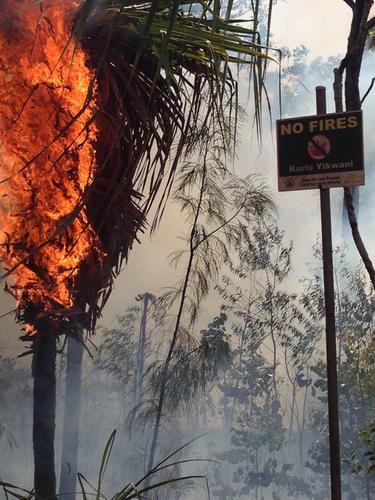当前位置:
X-MOL 学术
›
J. Appl. Ecol.
›
论文详情
Our official English website, www.x-mol.net, welcomes your feedback! (Note: you will need to create a separate account there.)
Investigating the effects of fire management on savanna biodiversity with grid‐based spatially explicit population simulations
Journal of Applied Ecology ( IF 5.7 ) Pub Date : 2020-11-24 , DOI: 10.1111/1365-2664.13801 Hugh F. Davies 1 , Casey Visintin 2 , Graeme R. Gillespie 3 , Brett P. Murphy 1
中文翻译:

通过基于网格的空间显式人口模拟研究火灾管理对热带稀树草原生物多样性的影响
更新日期:2020-11-24
Journal of Applied Ecology ( IF 5.7 ) Pub Date : 2020-11-24 , DOI: 10.1111/1365-2664.13801 Hugh F. Davies 1 , Casey Visintin 2 , Graeme R. Gillespie 3 , Brett P. Murphy 1
Affiliation

|
- The development of effective fire management for biodiversity conservation is a global challenge. The highly dynamic nature of fire, the difficulty in replicating ‘real‐world’ fire experiments and the need to understand population changes at large spatiotemporal scales make computer simulations particularly useful for identifying optimal fire management regimes for biodiversity conservation.
- We aimed to develop a flexible modelling approach with which to investigate how the spatiotemporal application of fire (i.e. management scenarios) influences savanna biodiversity. We used existing data from a landscape‐scale fire experiment to develop population simulations for the common brushtail possum Trichosurus vulpecula, grassland melomys Melomys burtoni and northern brown bandicoot Isoodon macrourus across the Kapalga area of Kakadu National Park in northern Australia. We simulated how populations were expected to change between 1995 and 2015 in response to the fire patterns observed at Kapalga over this period, and under a hypothetical management scenario of extensive prescribed burning.
- Our models predicted a substantial decline in all three species in response to the observed fire regime at Kapalga, suggesting that the fire patterns observed at Kapalga, with the associated mechanisms and interactions with other ecological processes, were not conducive with the persistence of native mammal populations.
- Our prescribed burning scenario had little effect on the predicted population trajectory of the common brushtail possum and grassland melomys, but markedly improved the population trajectory of the northern brown bandicoot. These inconsistencies highlight the need for a nuanced approach to fire management across northern Australian savannas, that is tailored to local conditions and management objectives.
- Synthesis and applications. The modelling approach outlined here provides a basis for identifying fire patterns that are beneficial for conserving biodiversity, thereby increasing our capacity to establish clear targets for prescribed fire management. Importantly, this approach is flexible and can be easily adapted to other taxa and fire‐prone ecosystems.
中文翻译:

通过基于网格的空间显式人口模拟研究火灾管理对热带稀树草原生物多样性的影响
- 发展有效的火灾管理以保护生物多样性是一项全球性挑战。火灾具有高度动态性,难以复制“真实世界”的火灾实验,并且需要了解大时空尺度上的种群变化,因此计算机模拟对于识别生物多样性保护的最佳火灾管理制度特别有用。
- 我们旨在开发一种灵活的建模方法,用以调查火灾的时空应用(即管理场景)如何影响热带稀树草原的生物多样性。我们使用了景观火试验的现有数据,对澳大利亚北部卡卡杜国家公园的卡帕尔加地区常见的带尾尖头负鼠Trichosurus vulpecula,草原melomys buromyi和北部棕色斑皮狗Isoodon macrourus进行了种群模拟。我们模拟了在此期间以及在假设的大规模处方燃烧管理情况下,预期人口如何根据1995年至2015年在Kapalga观察到的火灾模式而变化的情况。
- 我们的模型预测,对Kapalga观察到的火灾情况,这三种物种都会大量减少,这表明在Kapalga观察到的火灾模式及其相关机制和与其他生态过程的相互作用,不利于本地哺乳动物种群的持续生存。 。
- 我们规定的燃烧方案对常见的辫状负鼠和草原melomys的人口轨迹的预测影响不大,但显着改善了北棕带袋鼠的人口轨迹。这些不一致之处突显了需要针对澳大利亚北部大草原的火势管理采取细微差别的方法,该方法应根据当地条件和管理目标量身定制。
- 综合与应用。此处概述的建模方法为识别有利于保护生物多样性的火灾模式提供了基础,从而提高了我们为规定的火灾管理建立明确目标的能力。重要的是,这种方法非常灵活,可以轻松地适用于其他类群和易火的生态系统。

























 京公网安备 11010802027423号
京公网安备 11010802027423号